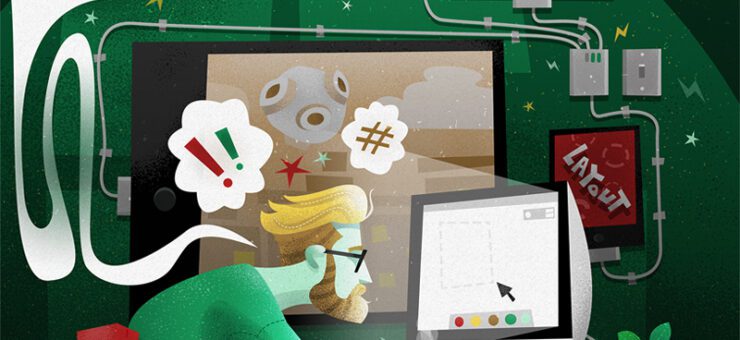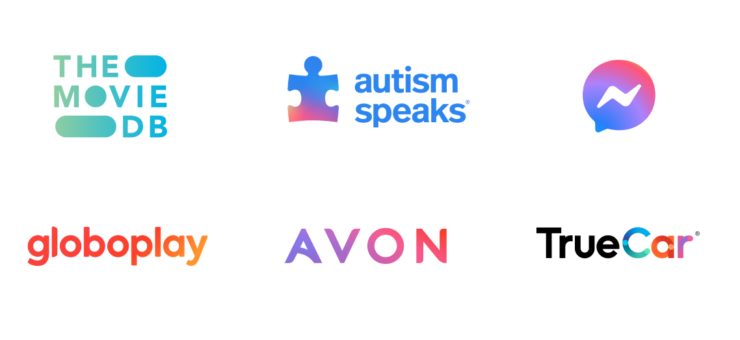I recently stumbled on a Reddit topic. A designer was complaining that some company stole his idea for the logo. Pretty common.
One of the commenters, however, caught my interest.
“Being unique is an effort. I recently got a gig – a cardio center was rebranding and asked if I could come up with a new logo for them. I was brainstorming ideas for two hours. Then I went and googled “cardio logo”. All my ideas were already there…”
Being unique is an effort? Certainly. What kind of effort, though? Is it about the unique inspiration we find somewhere or is it the unique way we look at this inspiration?
It’s getting harder to find unique inspiration. We have Pinterest boards, Google Images, and Dribbble featurettes, but they all pretty much show the same things. No wonder our work can be lost in the ocean of similarity.

And what about the way we look at these things? There are trends that affect us–we know what works “these days” and what not so much. It drastically hinders our ability to produce unique work.
And yet, some designers manage to do that. Among thousands of others, their work stands out. All the while their images make it to the top of the rating boards and gain plenty of attention.
I interviewed several of these designers whose shots I found on the front page of Dribbble and asked them a simple question:
How do you stay unique with your designs, when so many people are affected by the same visual trends, repetitive imagery on Pinterest & stocks, or just copy each other?
Here’s what they told me.
Jonathan Schubert, Designer & Illustrator

Jonathan: “Some of the base typefaces in use, like Devinne, are authentic to the time period – 19th-century apothecary labels, medicinal ads, alcohol, etc. The main type, however, was completely custom and achieved by a lot of messing around until something spoke to what I was generally envisioning. I wanted the logotype to match the natural aesthetic of the plant illustrations to come (no hard edges). The logotype(s) needed to feel rugged as well – the wilderness of northeast US / Canada, in general, being a bit of a backdrop to the brand I was imagining. I kept envisioning the brand coming from Montreal, ca 1900 – so the slight extravagance and character of the main logotype has a French litho poster feel to it, in my opinion. Adversely, the humble letter forms and natural edges give it a frontier utility that, to me, spoke to the masculinity and ruggedness of the brand.” Dribbble
Any time I’m starting a new project there is always a balance between taking inspiration from what’s currently being explored in the design / art / branding world and, in response to that, finding my own relevant contribution, amendment, or even complete rejection of it in order to arrive at something all my own. It’s a constant balancing act between what I personally love to explore and think is interesting, fresh, or right-on at the time (aka comfort zones), and the need to seek out that necessary discomfort which always pushes me into new territory.
It’s a constant balancing act between what I personally love to explore and think is interesting, and the need to seek out that necessary discomfort which always pushes me into new territory.
In real terms, the above formula means looking at other work I’m inspired by – and all the time. It’s part of what you have to do these days in order to keep up with what’s going on in the design and branding world. This inspiration will serve as a benchmark of either what to do – or – what not to do. In the case of the latter, it’s usually a project that has a well-traveled aesthetic or vibe which has become all too familiar to us. In the case of the former, it’s about understanding where others have contributed in a wonderful way to what I consider the best of (fill in the blank): this can be typography, concept, overall branding, etc. and simply taking note of that.
Inspiration will serve as a benchmark of either what to do – or – what not to do e.g. a project that has a well-traveled aesthetic or vibe which has become all too familiar to us.
I find it’s also extremely important to dig deep into additional material, references, and research to inspire each project. It’s about immersing myself into the world of whatever brand I may be developing – finding the subtle nuance narratives which inform any brand and building entire worlds around them. The more I know about the world my inspiration is derived from, the more original and inspired my solutions will be. Essentially, this is the difference between *only* looking at other design work for inspiration and putting that aside to find inspiration elsewhere. Again, a balancing act. Personally, I find the best inspiration comes from this latter category because it’s always the most honest, raw, and adventurous in terms of where it may lead.
It’s about immersing myself into the world of whatever brand I may be developing. The more I know about the world my inspiration is derived from, the more original and inspired my solutions will be.
Lastly, it’s important for me to love the process, the grind. For instance – I love exploring the juxtaposition of typefaces and how they play off each other to tell a story at a glance.

Jonathan: “This project found its inspiration in a classic apothecary aesthetic. The name, alone, communicates this message. The client requested some strong typography and a strong monogram for the “A”. I looked for simple apothecary / pharmacy labels and printed materials as I knew they would have a refined utility I could draw inspiration from. The “A” monogram actually came last because I had to sketch it out so many times to get the graphic balance and gestalt correct.” Dribbble
For me, it’s a universe of possibility – the same as one might feel when looking at a Pantone book. At the end of the day, it’s not about the way I feel when a project is wrapped and the brand suite is organized and pretty. It’s about that one moment I get on every project; when I’ve cranked on it for 3 hours or 3 days and something clicks and I’ve officially moved from a blurry vision in my subconscious to exactly where I wanted things to end up all along. It’s the “high” of the process.
It’s important for me to love the grind. It’s about that one moment when I’ve cranked on [the project] for 3 hours or 3 days and something clicks and I’ve officially moved from a blurry vision in my subconscious to exactly where I wanted things to end up.
The more excited I am about what it is I’m searching for the more original the end results will always be.
Anna Hurley, Illustrator
Technically, I’ve learned a lot through imitation. And it’s easy to just stop there. But my illustrations are made up of who I am and how I see the world, and I tend to be heavily influenced by the many different, wonderful things I’m able to consume, like films, books, art, video games, graphic novels, music–the list goes on and on.

Anna: “I think the prompt was just to draw a yeti flying a plane.The character was already established so I really liked the idea of putting him in an old toy cartoony plane with a little scarf flying out to indicate movement.” Dribbble
I try to take as much of that as I can and interpret them through my work. It’s not even a completely conscious action. I know this is kind of a vague answer, but I just try to make my work something that I enjoy, am proud of, and feels like me.
My illustrations are made up of who I am and how I see the world, and I tend to be heavily influenced by the many different, wonderful things I’m able to consume, like films, books, art, video games, graphic novels, music, the list goes on and on.
I don’t consciously try to make something unique. Since so many things have been done and there are so many similarities unbeknownst to me, there’s no way I can actually make something unique. All I can do is try to be true to myself and hope that uniqueness comes out in my work.

Anna: “I was just really wanting to relax and read and so I drew that. And I liked the idea of playing around with horizon lines and high contrast colors, it was just a fun study.” Dribbble
I don’t consciously try to make something unique. Since so many things have been done and there are so many similarities unbeknownst to me, […] All I can do is try to be true to myself and hope that uniqueness comes out in my work.
Manuel Cetina, illustrator

Manuel: “I made this illustration for a poster of a Hardcore and Noise tour bands. And the “keyboard stab” looks cool for the poster tour. A friend told me about the band in a vinyl party.” Dribbble
The internet is an awesome tool and the information can be amazing, but I love to buy old books and comics for inspiration. I love studying the design and the techniques, the compositions of old comics, the ink in the graphics, the halftones used in shadows, and the color key, especially in those with few colors.

Manuel: “There’s no a hidden message in the illustration. I made a Banana because it was the anniversary of a Sticker Party “Sticker x Sticker”. I think it was funny to use a banana and not a cake – it is the same feeling when you peel a banana and you “peel” a sticker you know when you take the back plastic.” Dribbble
I think the old school and analog forms is good inspiration tool for the digital era.
I love to buy old books and comics for inspiration. I love studying the design and the technique, the compositions to old comics, the ink in the graphics the halftones used in shadows…

Jack Kirby, “2001 A Space Odyssey”.
I love the work of Daniel Gillespie Clowes in “Ghost World”, Bernie Wrightson, Moebius,
Gustave Dore in “The divine comedy” and Jack Kirby in “2001 A Space Odyssey Comic”.
Martha Bergmann, Product Designer

Martha: “This animation is a good example of creating a variation of something and interpreting it with a new twist. I was inspired by this Dribbble post by Hoang Nguyen, and thought how cool would it be to recreate this transition in Studio and then be able to interact with it!” Dribbble
I wouldn’t say that I’m always 100% unique with my designs, but that’s just part of being a designer. Every day we’re absorbing new experiences, as a user when using our digital devices, and then as an observer when hopping into design communities online that share digital explorations. Naturally, we’re going to include pieces and parts of what we absorb into our own designs, which means trends will likely fall into them.
Take multiple trends and flip them on their head, or view them from a new angle. That’s how to stay more unique as a designer.
There’s something to be said for staying on trend with your designs, as you want your user interface to feel fresh and relatable with its users. But the absolute key here, which is what us designers should do to challenge ourselves, is to not fret about creating something that’s 100% trendy, or 100% unique, but instead maybe 50% unique.
One way to make unique designs is to combine elements and parts from multiple other designs. What you create from those ideas is a variation of how you uniquely envision the pieces and parts of the designs working together. We can learn so much from each other as designers. It can be about interpreting other designs with our own viewpoint or style
I look for inspiration from physical product design and packaging design. My mom’s a watercolor artist so I also find myself inspired by fine art examples. Sometimes, it’s as simple as being drawn to the color palette and trying to incorporate that into a design.
We should gather inspiration from multiple sources or even different mediums, such as architecture, and fuse them into a new exploration. I use architecture as an example since it’s quite different from digital design.

Martha: “One of my coworkers at InVision, Daniel Noskin, shared how he created a “gooey” shape in InVision Studio. Pablo Stanley tweeted about his variation on it here. I made a refresh animation with the same principle, and then expanded it further and did this animation above, which explores how a FAB can be playful.” Dribbble
I look for inspiration from physical product design, and packaging design. My mom’s a watercolor artist so I also find myself inspired by fine art examples. Sometimes it’s as simple as being drawn to the color palette and trying to incorporate that into a design.
There are all sorts of different mediums when you start to observe what you have around you.
Take multiple trends and flip them on their heads, or view them from a new angle. That’s how to stay more unique as a designer.
Brett Stenson, Art Director & Illustrator

Brett: “This tiger was based on my love for connecting angles across a composition and channeling the stiff aesthetics of a wood-carved figure. She’s chasing a butterfly to show that it’s a young tiger cub, curious about her new world.” Dribbble
I would start off by saying uniqueness is sort of based on each person’s view of design and their reasoning for making art in general. My work is influenced mostly by the music, environment, and personal worldview I experience. A lot of what inspires me feels like a caveman drew it, or music from deep in the jungle… places I can feel like I just traveled to in my mind. Sure, design can be ultra trendy and people tend to get inspired by one another – but I unabashedly did that for a long time too! I used to draw like Ed Roth for a while, but I didn’t enjoy it anymore, so I changed my focus.
My work is influenced mostly by the music, environment, and personal worldview I experience. A lot of what inspires me feels like a caveman drew it, or music from deep in the jungle… places I can feel like I just traveled to in my mind.
A lot of people are inspired by the Land Boys right now (shit I am too, those guys are amazingly creative and great at telling a story with most of the pages ripped out), but I personally think that’s ok. Someone will get inspired by them and build off of it and make something completely different with what they learned. Not to mention, many clients see that stuff and ask designers to do a certain style, which can be annoying. But sometimes that’s a part of our job.
Many clients see [some] stuff and ask designers to do a certain style, which can be annoying. But sometimes that’s a part of our job.
Along with all that, I just try to listen to myself and what I want to say. My goal is to make work that’s vibrant, fun, primitive, and iconic, but mostly, I need to enjoy it when I make it. My inspiration comes from a lot of other amazing designers and artists of the present and long past, and I guess I’m not ashamed of that. I look at stuff people make and try to appreciate their process or their approach to the composition, colors, whatever!

Brett: “This illustration is an homage to The Body, a band known for its haunting thematics of desolation, isolation, and jarring distortion. In the drawing, there is a plague doctor galloping upon a dead horse, which felt like the right symbolism for an album that sounds like a village in the Middle Ages burning to the ground.” Dribbble
From there, just digest and try to put it through my own lens. Inspiration and homage are beautiful things when there are good intentions.
My inspiration comes from a lot of other amazing designers and artists of the present and long past, and I guess I’m not ashamed of that. […] Inspiration and homage are beautiful things when there are good intentions.
Afterword
It seems like everyone puts in a unique effort to be, well… unique. It has to do with both the source of inspiration and the way designers use it.
Someone may be inspired by old books and comics, and someone by tribal music and package designs. However, it’s something that people really like that eventually finds its way into their work and resonates with it.
As for the way designers use inspiration, that’s different as well. Some of them are directly inspired by the work of their fellow artists, while others channel the perception into their work indirectly, trying to convey a certain feeling rather than a style.
It’s getting increasingly complex to stay unique these days. And one cannot stay that way for long, because he or she will always inspire a cohort of followers. However, there’s one thing in common between all the designers I interviewed. I noticed that they all allow a bit of themselves in their work.
No matter the competition, one can always stay true to themselves and their worldview, even using all the latest trends and tools. Hopefully, other people will feel that.
About the author: Andrew started at Icons8 as a usability specialist, conducting interviews and usability surveys. He desperately wanted to share his findings with our professional community and started writing insightful and funny (sometimes both) stories for our blog.
Title image: Ouch! Icons8 illustration project
Check the handy lists of free graphic design software, read about top trends on graphic design and UI design, and review the basics of creating vector illustrations.




